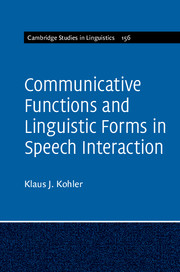Communicative Functions and Linguistic Forms in Speech Interaction
Prosody is generally studied at a separate linguistic level from syntax and semantics. It analyses phonetic properties of utterances such as pitch and prominence, and orders them into phonological categories such as pitch accent, boundary tone, and metrical grid. The goal is to define distinctive formal differentiators of meanings in utterances. But what these meanings are is either excluded or a secondary concern. This book takes the opposite approach, asking what are the basic categories of meaning that speakers want to transmit to listeners? And what formal means do they use to achieve it? It places linguistic form in functions of speech communication, and takes into account all the formal exponents - sounds, words, syntax, prosodies - for specific functional coding. Basic communicative functions such as 'questioning' may be universally assumed, but their coding by linguistic bundles varies between languages. A comparison of function-form systems in English, German and Mandarin Chinese shows this formal diversity for universal functions.
- Relates experimental signal data to communicative categories in communicative phonetic science
- Moves from function to form, rather than the traditional reverse practised in linguistics
- Provides comparative descriptions of the prosodic systems of English and German, and a partial comparison with Mandarin Chinese, in relation to the communicative functions of representation, appeal and expression
Product details
November 2017Hardback
9781107170728
318 pages
235 × 156 × 18 mm
0.63kg
39 b/w illus.
Available
Table of Contents
- Introduction
- 1. Speech communication in human interaction
- 2. Prosody in a functional framework: the Kiel Intonation Model (KIM)
- 3. The representation function
- 4. The appeal function
- 5. The expression function
- 6. Linguistic form of communicative functions in language comparison.



